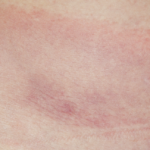The importance of including a placebo group in these antibiotic trials is critical in ferreting out whether long-term antibiotics improve outcomes in Lyme disease. The placebo group, along with the active antibiotic group, improved as much as 40% from baseline in the antibiotic trials.
Back to the Case
But Ms. Corinth’s case is not within the spectrum of Lyme disease. Her diagnosis was based solely on a questionnaire. Her Lyme tests were never positive, and her subjective symptoms, although often seen in Lyme, overlap with symptoms of stress, anxiety, depression and a host of other painful medical conditions. The key to her diagnosis is the swollen knee. In my mind, if this can be diagnosed and treated, the other symptoms may slowly dissipate. After all, the bottom line is that she has gone from working full time to being disabled, from healthy to chronically ill.
So it was with some sense of optimism that I returned to the room and stated my case. “I have some good news for you, Ms. Corinth. I’m confident that I can treat your knee and get you back on track. I can’t comment on what happened to you two years ago. I don’t know if you had Lyme disease then, but I’m quite sure you don’t have Lyme disease now. What I think you …”
For a moment, stunned silence. Then her face collapsed, and she buried her head in her hands, sobbing uncontrollably. “You don’t believe me, either. I knew it. My sister said I should come see you, but you don’t believe me. You don’t believe me.”
I handed her a tissue, and she dabbed her eyes. Could I have phrased my thoughts differently? “Please. Wait. Let me explain. I believe I can help you,” I continued, as she gathered her notebook and purse to leave. “Do you need a minute? I can wait.”
I cracked my neck to the right. My throat was dry. An involuntary, barely visible tremor in my right index finger drew my attention. Hello old friend. To occupy the index finger, I surreptitiously palpated my pulse on the other hand. That’s strange. I’m sweating like a pig and about to ignite from stress and my pulse is a rock-steady 60 per minute. Go figure. The human body is a strange admixture of mind–body interactions. Some make sense; some don’t.
She stood and dropped her glasses, bent and an envelope fluttered to the floor. Collapsing back in her seat, she held the notebook against her chest as if I might pry her story away. Week by week, month by month, she has battled progressive pain and fatigue, learned all she could about the mystery and complexities of living with chronic Lyme disease, and I’m telling her the doctor she’s placed complete trust in has it all wrong.
Psoriatic Arthritis
“The good news is that you have psoriatic arthritis. The scaly patches on your elbow and thigh are psoriasis. The pits on the fingernail and the lifting up of the edge of the nail represent psoriatic nail involvement. The swollen knee: psoriatic arthritis.”


